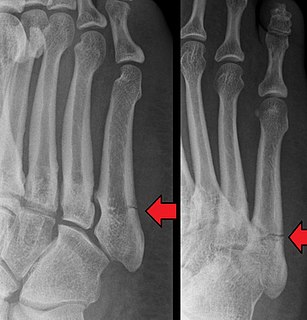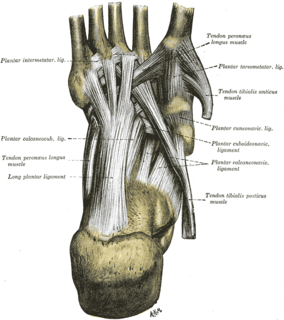
The foot is an anatomical structure found in many vertebrates. It is the terminal portion of a limb which bears weight and allows locomotion. In many animals with feet, the foot is a separate organ at the terminal part of the leg made up of one or more segments or bones, generally including claws or nails.

A bunion, also known as hallux valgus, is a deformity of the joint connecting the big toe to the foot. The big toe often bends towards the other toes and the joint becomes red and painful. The onset of bunions is typically gradual. Complications may include bursitis or arthritis.

A Jones fracture is a break in a specific part of the fifth metatarsal of the foot between the base and middle part known for its high rate of delayed healing or nonunion. It results in pain near the midportion of the foot on the outside. There may also be bruising and difficulty walking. Onset is generally sudden.

A Lisfranc injury, also known as Lisfranc fracture, is an injury of the foot in which one or more of the metatarsal bones are displaced from the tarsus.
Metatarsalgia, literally metatarsal pain and colloquially known as a stone bruise, is any painful foot condition affecting the metatarsal region of the foot. This is a common problem that can affect the joints and bones of the metatarsals.

Microraptoria is a clade of basal dromaeosaurid theropod dinosaurs. The first microraptorians appeared 125 million years ago in China. Many are known for long feathers on their legs and may have been semi-arboreal powered fliers, some of which even capable of launching from the ground. Most microraptorians were relatively small; adult specimens of Microraptor range between 77–90 centimetres long (2.53–2.95 ft) and weigh up to 1 kilogram (2.2 lb), making them some of the smallest known non-avialan dinosaurs.

The Flexor digiti minimi brevis lies under the metatarsal bone on the little toe, and resembles one of the Interossei.

Morton's toe is the condition of having a first metatarsal which is short in relation to the second metatarsal. It is a type of brachymetatarsia.

Hulsanpes is a genus of halszkaraptorine theropod dinosaurs that lived during the Late Cretaceous in what is now the Barun Goyot Formation of Mongolia, about 75-72 million years ago. The remains were found in 1970 and formally described in 1982 by Halszka Osmólska, who noted that the genus is represented by an immature individual. Hulsanpes represents the first record of the basal dromaeosaurid subfamily Halszkaraptorinae.

The metatarsophalangeal joints are the joints between the metatarsal bones of the foot and the proximal bones of the toes. They are condyloid joints, meaning that an elliptical or rounded surface comes close to a shallow cavity.

The arches of the foot, formed by the tarsal and metatarsal bones, strengthened by ligaments and tendons, allow the foot to support the weight of the body in the erect posture with the least weight.

The lateral plantar artery, much larger than the medial, passes obliquely lateralward and forward to the base of the fifth metatarsal bone.

The plantar metatarsal arteries are four in number, arising from the convexity of the plantar arch. They run forward between the metatarsal bones and in contact with the Interossei. They are located in the fourth layer of the foot.

The medial plantar artery, much smaller than the lateral plantar artery, passes forward along the medial side of the foot.

Yungavolucris is a genus of enantiornithean birds. It contains the single species Yungavolucris brevipedalis, which lived in the Late Cretaceous. The fossil bones were found in the Lecho Formation at estancia El Brete, Argentina."Yungavolucris brevipedalis" means "Short-footed Yungas bird". The generic name, Yungavolucris is after the Yungas region + the Latin volucris, which translates to "bird". The specific name brevipedalis is from the Latin brevis, which means "short", + pedalis, from the Latin pes, meaning "foot".

The plantar tarsometatarsal ligaments consist of longitudinal and oblique bands, disposed with less regularity than the dorsal ligaments.

Bauxitornis is an extinct genus of avisaurid enantiornithean birds which lived in what is now Hungary during the late Cretaceous period. Although first mentioned in a 2008 review of Hungarian Cretaceous bird fossils, it was named in a more comprehensive review by Gareth J. Dyke and Attila Ősi in 2010. The type species is Bauxitornis mindszentyae. The generic name "Bauxitornis" refers to the locality at which it was discovered, a Bauxite mine. The specific name "mindszentyae" honors Andrea Mindszenty, Ősi's advisor.
Brodavis is a genus of freshwater hesperornithiform birds known from the Late Cretaceous of North America and Asia. It was first described and named by Larry D. Martin, Evgeny N. Kurochkin and Tim T. Tokaryk in 2012 and assigned to a new monogeneric family, Brodavidae. Four species were described and assigned to Brodavis.

Freiberg disease, also known as a Freiberg infraction, is a form of avascular necrosis in the metatarsal bone of the foot. It generally develops in the second metatarsal, but can occur in any metatarsal. Physical stress causes multiple tiny fractures where the middle of the metatarsal meets the growth plate. These fractures impair blood flow to the end of the metatarsal resulting in the death of bone cells (osteonecrosis). It is an uncommon condition, occurring most often in young women, athletes, and those with abnormally long metatarsals. Approximately 80% of those diagnosed are women.
Phuwiangvenator is a genus of megaraptoran theropod that lived during the Early Cretaceous period in what is now Thailand. It contains a single species, P. yaemniyomi, recovered from the Sao Khua Formation. The holotype was first found in 1993, before being named in 2019. The holotype specimen consists of a partial skeleton consisting of a dorsal vertebra, three fused sacral vertebrae, right metacarpal II, right manual phalanges and unguals, right and left tibiae, left astragalocalcaneum, left metatarsal I, right metatarsals II–IV, right pedal phalanges and unguals, with a referred specimen including an atlantal intercentrum and right astragalocalcaneum which were found together. In the phylogenetic analyses it was found to be the basalmost megaraptoran. Additional specimens have also been found in 2021.















